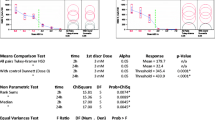Summary
The in vitro myelotoxic potentials of three investigational antitumor agents, Fostriecin, Hepsulfam and pyrazine diazohydroxide (PZDH), were evaluated utilizing clonogenic assays. Human and murine marrow cells were exposed to each drug for 1 hr prior to culture in microcapillary (human) or Petri dish (murine) assays. Fostriecin (0.22–220 μM), Hepsulfam (0.34–340 μM) and PZDH (0.68–680 μM) inhibited myeloid (CFU-gm), erythroid (BFU-e, CFU-e) and megakaryocytic (CFU-meg) colony formation in a concentration-dependent manner. CFU-e from both species were more sensitive to Fostriecin than the other progenitors and murine cells more sensitive overall to Fostriecin than their human counterparts. Murine CFU-e were also more sensitive to Hepsulfam than human CFU-e, with CFU-gm and BFU-e being similarly affected in both species. Human BFU-e were greatly inhibited by PZDH, whereas murine BFU-e were relatively resistant to its toxic effects. Fostriecin was the most toxic of the three antitumor agents, with PZDH the least toxic.
Similar content being viewed by others
References
Scheithauer W, Von Hoff DD, Clark GM, Shillis JL, Elslager EF: In vitro activity of the novel antitumor antibiotic fostriecin (CI-920) in a human tumor cloning assay. Eur J Cancer Clin Oncol 22:921–926, 1986
Waud WR, Plowman J, Paull KD, Narayanan VL, Bailey DM, Harrison SD, Dykes DJ, Laster WR, Griswold DP: Preclinical antitumor activity of Hepsulfam (NSC-329680). (Abstract) Proc Amer Assoc Cancer Res 29:1323, 1988
Baker DC, Hand ES, Plowman J, Rampal JB, Safavy A, Haugwitz RD, Narayanan VL: Synthesis, chemical stability and preclinical anti-tumor activity of pyrazine diazohydroxide, sodium salt (NSC-361456). Anti-Cancer Drug Design 2:297–309, 1987
Boritzki TJ, Wolfard TS, Besserer JA, Jackson RC, Fry DW: Inhibition of type II topoisomerase by Fostriecin. Biochem Pharmacol 37:4063–4068, 1988
Jackson RC, Fry DW, Boritzki TJ, Roberts BJ, Hook KE, Leopold WR: The biochemical pharmacology of CI-920, a structurally novel antibiotic with antileukemic activity. Adv Enzyme Regulation 23:193–215, 1985
Leopold WR, Shillis JL, Murtus AE, Nelson JM, Roberts BJ, Jackson RC: Anticancer activity of the structurally novel antibiotic CI-920 and its analogues. Cancer Res 44:1928–1932, 1984
Pacheo DY, Stratton NK, Gibson NW: Comparison of the mechanism of action of Busulfan with Hepsulfam, a new antileukemic agent, in the L1210 cell line. Cancer Res 49:5108–5110, 1989
Plowman J, Haugwitz RD, Narayanan VL, Baker DC, Hand ES, Rampal JB, Safavy A: Preclinical antitumor activity of pyrazine diazohydroxide, NSC 361456. (Abstract) Proc Amer Assoc Cancer Res 27:275, 1986
Brodfuehrer JI, Moore DJ, Melder DC, Wilke TJ, Powis G: In vitro cytotoxicity of pyrazine-2-diazohydroxide: specificity for hypoxic cells and effects of microsomal coincubation. Invest New Drugs 6:3–9, 1988
Wittberg KL, De Wall RA, Murphy Jr MJ: Acquisition and clonal growth of human sternal bone marrow obtained incidental to open-heart surgery. Expl Cell Biol 53:41–45, 1985
Du DL, Volpe DA, Grieshaber CK, Murphy Jr MJ: Effects of L-phenylalanine mustard and L-buthionine sulfoximine on murine and human hematopoietic progenitor cells in vitro. Cancer Research 50:4038–4043, 1990
Busch FW, Schmittele U, Ehninger G: Toxicity of novel anthracycline derivatives towards normal myeloid bone marrow progenitor cells (CFU-GM) is not increased by verapamil. Blut 60:219–222, 1990
Schroyens WA, Meeker JB, Dodion P, Stryckmans PA, Rozencweig M: Comparative effect of cisplatin, spiroplatin, carboplatin, iproplatin and JM40 in a human myeloid clonogenic assay. Eur J Cancer Clin Oncol 24:1309–1312, 1988
Du DL, Volpe DA, Murphy Jr MJ: Microcapillary clonogenic assays for human bone marrow hematopoietic progenitor cells. Int J Cell Cloning 7:303–313, 1989
Burgess AW, Wilson EM, Metcalf D: Stimulation by human placental conditioned medium of hematopoietic colony formation by human marrow cells. Blood 49:573–583, 1977
Gallicchio VS, Murphy Jr MJ: In vitro erythropoiesis. II. Cytochemical enumeration of erythroid stem cells (CFU-e and BFU-e) from normal mouse and human hematopoietic tissues. Exp Hematol 7:219–224, 1979
Ali-Osman F, Giblin J, Berger M, Murphy Jr MJ, Rosenblum ML: Chemical structure of carbamoylating groups and their relationship to bone marrow toxicity and antiglioma activity of bifunctionally alkalating and carbamoylating nitrosoureas. Cancer Res 45:4185–4191, 1985
Murphy Jr MJ, Sullivan ME: Culture of erythroid stem cells from murine and human marrow and blood. In: Murphy Jr MJ (ed) In Vitro Aspects of Erythropoiesis. Springer-Verlag, New York, 1978, pp 262–265
Johnson GR, Metcalf D: Pure and mixed erythroid colony formation in vitro stimulated by spleen-conditioned medium with no detectable erythropoietin. Proc Natl Acad Sci USA 74:3879–3882, 1977
McLeod DL, Shreeve MM, Axelrad AA: Improved plasma culture system for production of erythrocytic colonies in vitro quantitative assay method for CFU-e. Blood 44:517–534, 1974
Kuriya S, Kwak J, Tajika J, Minoda Y, Nomura T, Murphy Jr MJ: Cloning of murine megakaryocyte progenitor cells in a fibrin clot culture system. Exp Hematol 15:587–590, 1987
Nakeff A, Daniels-McQueen S: In vitro cloning assay for a new class of megakaryocyte precursor: colony forming unit megakaryocyte (CFU-M). Proc Soc Exp Bioi Med 151:587–590, 1976
Fry DW, Boritzki TJ, Besserer JA: Evidence that the antitumor antibiotic, CI-920, is transported into L1210 leukemia cells by the reduced folate carrier system. (Abstr) Proc Am Assoc Cancer Res 24:351, 1984
Howard CT, Leopold WR, Sebolt JS, Jackson RC: Characterization of a murine leukemia cell line selected for in vivo resistance to CI-920 (phosphotrienin). (Abstr) Proc Am Assoc Cancer Res 26:339, 1985
Liao JT, Merriman TN, Collins WT, Smith AC, Kastello MD, Grieshaber CK: Toxicological and pharmacokinetic evaluation of pyrazine diazohydroxide (NSC-361456). (Abstr) Proc Amer Assoc Cancer Res 29:511, 1988
El-hawari M, Stoltz M, Maldinger B, Stedhan M, Kastello M, Smith A, Grieshaber C: Preclinical toxicology and pharmacokinetics of hepsulfam (1,7-heptanediol disulfamate, NSC-329680). (Abstr) Proc Amer Assoc Cancer Res 29:2026, 1988
Marshall MV, Havlin KA, Brown TD, Weiss GR, Koeller JM, Rodriguez G, Cagnola J, Von Hoff DD, Kuhn JG: Pharmacokinetics of hepsulfam (sulfamic acid 1,7-heptanediyl ester), a new phase I agent. (Abstr) Proc Amer Assoc Cancer Res 31:206, 1990
Author information
Authors and Affiliations
Rights and permissions
About this article
Cite this article
Du, DL., Volpe, D.A., Grieshaber, C.K. et al. Comparative toxicity of fostriecin, hepsulfam and pyrazine diazohydroxide to human and murine hematopoietic progenitor cells in vitro . Invest New Drugs 9, 149–157 (1991). https://doi.org/10.1007/BF00175082
Issue Date:
DOI: https://doi.org/10.1007/BF00175082




